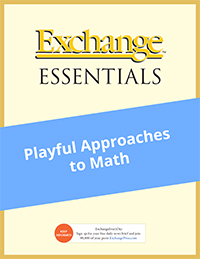ExchangeEveryDay Past Issues
 << Previous Issue
| View Past Issues | | Next Issue >>
<< Previous Issue
| View Past Issues | | Next Issue >> -Pierre Teilhard de Chardin
In their new professional development film, Reflecting on Anti-Bias Education in Practice: The Early Years, released for free screening, Debbie LeeKeenan and John Nimmo intentionally sought out a diversity of teachers and programs to tell the story. One question that has come up from viewers is how the ideas apply to settings that are predominantly White. Debbie and John offer the following advice:
“The anti-bias approach is intended for all kinds of settings, regardless of the community’s diversity. The four anti-bias goals of identity, diversity, justice and action are relevant for all children. Of course, where you start and what strategies and curriculum you use may differ depending on your context.
One helpful resource is the book What If All the Kids are White? Anti-Bias Multicultural Education with Young Children and Families (2011) by Derman-Sparks, Ramsey, and Edwards. Here is a short resource they put together. You can begin by exploring the intersecting diversities that already exist (across gender, ability, social class, heritage, languages, gender expression, age, religion, etc.) even when a group is predominantly White. There are other things you can do to extend the children’s world - to provide meaningful 'windows' into diversity. For instance, you or people in your community (including parents, businesses, and local organizations) might have family members, friends, or colleagues who have different racial and ethnic backgrounds who might be willing to be part of your program in meaningful ways, either through a field trip or a guest visit. Strive for lasting relationships rather than a one time event. There is much diversity to discover beyond the immediate school community.
Young children are already observing racial diversity around them in the media and as they venture outside their families, and are forming ideas about what these differences mean. Quality children’s literature is another way for children to discover people and experiences outside their immediate world. We can help them make connections about what is similar and what is different. Read stories that provide children with multiple perspectives and layers that also engage children in conversations about what they are thinking. For example, look for stories, situations and characters that resonate for your children because of a shared or similar experience. You can also use persona dolls, as shown in the film, to introduce characters with complex and authentic stories, and that include similarities and differences from the children in your classroom. The Guidebook that accompanies the film is packed full of additional resources. Be creative, do your research, and make connections beyond your own community.”
Playful Approaches to Math |
ExchangeEveryDay
Delivered five days a week containing news, success stories, solutions, trend reports, and much more.
What is ExchangeEveryDay?
ExchangeEveryDay is the official electronic newsletter for Exchange Press. It is delivered five days a week containing news stories, success stories, solutions, trend reports, and much more.



Post a Comment